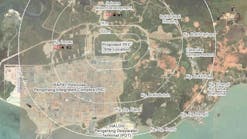Guntis Moritis
OGJ Production Editor
HOUSTON, Dec. 2 -- Only two tailings management plans for oil sands mining operations comply with the new Alberta Energy Resources Conservation Board (ERCB) Directive 074, according to a Pembina Institute & Water Matters Society of Alberta review.
The oil sands extraction process creates tailings, which are a fluid mixture of water, sand, silt clay, unrecovered hydrocarbons, and dissolved chemicals. The review noted tailings are toxic and cannot be released into the environment. The sand and other coarse solids in tailings settle, but fine solids remain suspended in the water and require long-term containment.
The review said the number of liquid tailings lakes continues to increase in Alberta and in 2009 covered an area of about 130 sq km.
In February, ERCB announced new rules for regulating tailings reclamation. “The new regulations were announced in part because oil sands operators were not meeting targets set out in their original applications,” the review said.
Oil sands mining companies submitted tailings management plans to the ERCB on Sept. 30 in accordance with Directive 074: Tailings Performance Criteria and Requirements for Oil Sands Mining Schemes. The directive requires operators to reduce toxic tailings by capturing or extracting the fine particles from the wastewater and then storing the captured solids in disposal areas. The submitted management plans outline how companies would start to reduce the tailings waste.
The review noted the directive requires companies to:
• Capture a minimum portion of fine particles from the tailings. The capture rate (defined as a percentage of total fine particles in the raw oil sands material) increases during 3 milestone years: 20% by June 30, 2011; 30% by June 30, 2012; and 50% by June 30, 2013.
• Create disposal areas for storing the captured particles.
• Ensure the disposal areas meet ERCB's minimum load-bearing strength.
• Prepare annual plans and reports on tailings.
The review found only two of nine projects would meet regulatory requirements starting in 2011. It noted some proposed plans would not meet reductions until 2023 and would not meet rules for developing solid surfaces for more than 40 years.
The plans for the Suncor Energy Inc. Millennium and North Steepbank mine and the Fort Hills Energy Ltd. mine met the ERCB rules, according to the review. Because Petro-Canada, the operator of Fort Hills, merged with Suncor, Suncor submitted the plan for Fort Hills.
The review said plans not meeting the new rules included the Canadian Natural Resources Ltd.’s Horizon; Imperial Oil Ltd.’s Kearl: Shell Canada Ltd.’s Muskeg River and Jackpine; and Syncrude Canada Ltd.’s Mildred Lake, Aurora North, and Aurora South projects.
A copy of the Pembina and Water Matters review is available at www.oilsandswatch.org/pub/1934.
Contact Guntis Moritis at [email protected].


